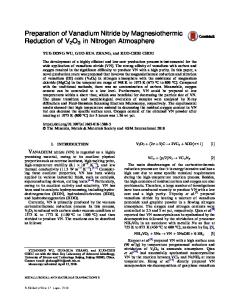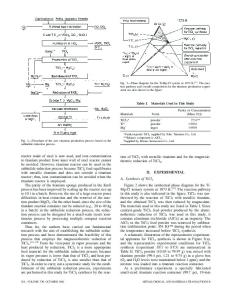Preparation of porous zirconium microspheres by magnesiothermic reduction and their microstructural characteristics
- PDF / 390,967 Bytes
- 6 Pages / 584.957 x 782.986 pts Page_size
- 69 Downloads / 328 Views
Hayk H. Nersisyan Rapidly Solidified Materials Research Institute, Chungnam National University, Daejeon 305-764, Republic of Korea
Byong-Sun Chun Korea Institute of Science and Technology Information, ReSEAT Program, Daejeon 305-806, Republic of Korea
Jong-Hyeon Leea) Graduate School of Green Energy Technology, Chungnam National University, Daejeon 305-764, Republic of Korea (Received 2 March 2011; accepted 23 June 2011)
Porous zirconium metal microspheres were synthesized successfully by a combustion technique using ZrO2 + 2Mg starting mixture. In this process, a controlled amount of KClO3 + 3Mg is mixed with ZrO2 + 2Mg to enable a self-sustaining combustion process and to promote a reduction of the ZrO2. The framework structure, morphology, and porosity of zirconium microspheres were determined using various techniques. Microscopic visualization suggested that the spherical structure has macroporous windows of diameter ;0.5–5.0 lm and the space between the macropores has a wormhole-like mesoporous/microporous structure. The mesoporous structure had a pore diameter of ;1.19 nm. This procedure provides an easy method for the synthesis of porous microspherical assemblies of Zr composed of submicrometer size particles.
I. INTRODUCTION
The design and synthesis of porous materials remains important to scientific and technological fields owing to their wide range of applications, e.g., catalysts, catalyst support, molecular sieves, porous membrane and filters, gas sensors, drag carriers, electrodes, anode components of host-guest systems.1,2 Several methods have been developed to synthesize porous material with different pore sizes: macropore (.50 nm), mesopore (2–50 nm), and crystalline micropore (,2 nm). In the synthesis of porous metal structures, a template approach based on open (or closed) cell polymers is generally used. For example, precision investment casting is used to manufacture open-cell stochastic foams cast from Al-, Cu-, Mg-, and Zn-based alloys.3,4 The process uses an open-cell polyurethane foam template that is burned out to produce a negative mold that is filled with molten metal. After solidification, the investment is removed by water spray or other mechanical means to leave behind the open-cell stochastic metal foam. Queheillalt et al.5 reported using a)
Address all correspondence to this author. e-mail: [email protected] DOI: 10.1557/jmr.2011.217 J. Mater. Res., Vol. 26, No. 16, Aug 28, 2011
http://journals.cambridge.org
Downloaded: 25 Mar 2015
the solid-state approach to produce open-cell stochastic metal foams from a nickel-based Ni–21Cr–9Mo–4Nb superalloy. This approach is based on transient liquid phase sintering of metal powders deposited on open-cell stochastic carbon foam templates. Other approaches to fabricating three-dimensionally porous metals include partial sintering of powders6 or wires7 and sintering of powders around a temporary space-holding phase such as sodium chloride powder.8 The combustion synthesis process is also known to produce various inorganic materials with a poro
Data Loading...








